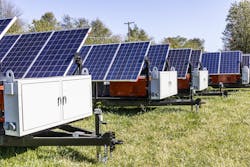Rapidly deployable solar microgrids for lower power applications
When most people think of microgrids, they think of large-scale solutions that are developed to support hardened infrastructure, aiding the utility grid with islanding capabilities. These systems are typically custom engineered, requiring lengthy design and construction processes.
- Utility interconnection can be challenging or cost prohibitive if the power needed is in a remote area without existing infrastructure.
- Interconnection time can be months to years, depending on the utility’s backlog and priorities.
- Building interconnection can involve significant modification, sometimes requiring load shifting.
- Expected system operation could be short – maybe only months – for temporary situations, with nonrecoverable installation expenses.
- Fossil fuel generators can be difficult to deploy and power remotely, and they create unwanted emissions. States such as California are banning the sale of gas-powered generators beginning in 2028, so alternative methods need to be considered.
Fortunately, this is where microgrids can shine. Low-power rapidly deployable microgrids supported by solar can be the answer for organizations with temporary power or off-grid needs. Think of them as off-the-shelf options that can quickly meet a variety of power needs. Thanks to their standard configurations and modularity, they can aid in providing clean power quickly.
Rapidly deployable solar microgrids can be highly effective in the following scenarios:
- Emergency power following a major storm or other natural disaster.
- Temporary deployment of event power.
- Resilient power for remote homes and communication towers.
- Supplemental off-grid power for electric vehicle (EV) chargers.
As noted, quickly deployable microgrids are becoming more popular for EV charging applications. For example, a business that has ordered a number of electric fleet vehicles may need a utility service upgrade before charging infrastructure can be developed to support the vehicles. Rapidly deployable microgrids can provide clean energy EV charging in weeks, not months, while the utility upgrades are in progress. In addition, powering electric vehicles with solar power reduces overall emissions to nearly zero, compared to charging them from the utility grid (depending on location).
It’s important to remember that even if a microgrid is temporary or requires rapid deployment, it can also support your energy goals of resilience, sustainability and cost savings.
Standard configurable microgrids in smaller sizes (under 20 kW) built into industrial control enclosures or small containers can solve many energy challenges. These lower power microgrids, which include solar generation and battery energy storage, can be shipped to site mostly assembled, commissioned quickly and be operational in days, versus the months required by large-scale, grid-tied microgrid systems.
Mike Collom is director of strategic accounts for EnTech Solutions.

